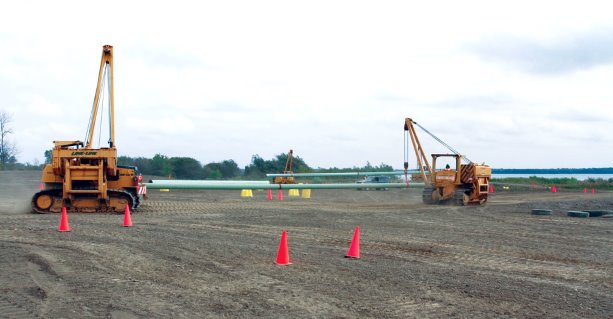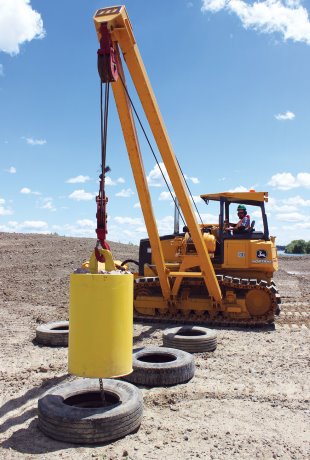The Energy East oil pipeline is far from a sure thing as National Energy Board (NEB) hearings get underway this week, but what is certain is that if and when the project gets a green light, hundreds of Ontario’s operating engineers will be ready to get right to work.
Anticipating the need for trained pipeline operators, the Operating Engineers Training Institute of Ontario (OETIO) campus in Morrisburg, Ont. launched a three-week training program for operators of dozers, sidebooms and excavators in June 2015. OETIO executive director Harold McBride reported recently that the program has already graduated 174 newly skilled operating engineers since the program debuted, with hopes to match that output in the next 15 months.
McBride acknowledged that Energy East faces opposition that could derail the project but he said the training centre really has no option but to train workers to be ready to go come 2018, when the NEB is scheduled to present its recommendations.
"Here is the way we look at it," said McBride. "Everyone is sitting on the fence, but if we didn’t prepare ahead, we wouldn’t be able to supply the demand. So if we wait until it is totally confirmed, we won’t have time to train the people needed and it would allow foreign workers to come in."
The $15.7-billion Energy East pipeline project proposed by TransCanada Corporation would move 1.1-million barrels of oil a day 4,600 kilometres from Hardisty, Alta. through the prairies, Ontario and Quebec and into New Brunswick to supply local refineries and overseas shipping. There would be new pipeline built and also conversion of existing lines.
Opposition has come from several sources including Montreal-area mayors and environmental groups such as the Natural Resources Defence Council, which last week warned increased tanker traffic off the east coast could result in environmental disaster in the event of a spill.
NEB hearings began Aug. 8 in Saint John, N.B. If the project eventually gets off the ground, estimates indicates that 4,800 new operating engineers would be needed to build mainlines across the country. The International Union of Operating Engineers Local 793, which undertakes its trades training at the Morrisburg site and also at another centre in Oakville, Ont., recently announced through its business manager Mike Gallagher it had signed a memorandum of understanding with the Pipe Line Contractors Association of Canada and TransCanada to secure its participation in the build if approvals are obtained. The OETIO purchased two John Deere 850 sidebooms at a cost of $1.35 million and two used D6 dozers at a cost of $373,000 as part of its investment in the pipeline training program.
"The pipeline industry has specific operating techniques and procedures that need to be practised with certain equipment," McBride said. "The sideboom is a specific piece of equipment designed for pipeline work."
Trainees spend part of each morning in OETIO classrooms learning about such matters as provincial Occupational Health and Safety Act regulations related to the pipeline industry and also pipeline-specific federal environmental regulations.
"Those regulations are extremely strict now," said McBride. "We make sure they are compliant in understanding the new regulations."
The rest of the day, the operators are on the OETIO training field practising techniques.
"We’ve recreated a pipeline spread," said McBride. "Everything that happens in the process of putting the pipeline in the ground, we have recreated those scenarios in the pipeline environment."
A significant part of the learning is calculating loads and learning to work in tandem with other sideboom operators. At OETIO they work with pipeline that is 36 inches in diameter, a half-inch thick, and welded to a combined length of 120 feet, McBride explained. But out on a mainline job, the operator might be working as part of a team of seven to 10 sideboom operators carrying a string of pipe up to 600 metres long.
Working on the mainlines that will be built if Energy East goes ahead would be lucrative work for trained operating engineers, said McBride — they can expect to earn $2,000 to $3,000 per five-day week.
"It is a very good paying job," he said.
Even if Energy East is nixed, McBride said many of the operators they are training will be able to take their skills abroad, or else find pipeline jobs on natural gas distribution projects underway in Ontario.
"If it doesn’t happen, we have created the skills for our operators where they can go anywhere in the world now," he said. "You’re an operating engineer for Local 793 in Ontario today but tomorrow you could transfer to Saskatchewan. It is all about that, mobility, a workforce that can move across the country.
"And there is a lot of work going on right now in distribution. All the new subdivisions are being hooked up with natural gas. So this course gives the skills to run smaller equipment on these types of projects."






Recent Comments
comments for this post are closed